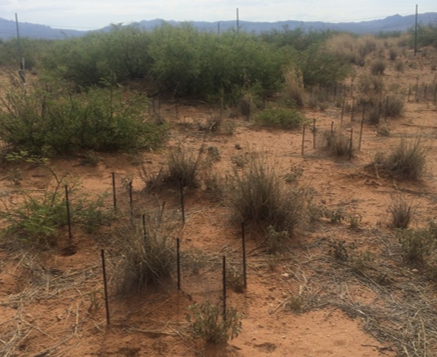Shrub-dominated ecosystem states in drylands are believed to be stable under current climatic conditions as a result of positive feedbacks between woody plants, soil water, and nutrients, making grass recovery rare and restoration difficult. However, under favorable environmental conditions and through restorative management, we have observed the re-establishment and recovery of previously-degraded grasslands in the Jornada Basin. The studies below highlight both the stability of established shrub states and the favorable conditions (such as precipitation or herbivory) that can lead to desert grassland recovery.
Research Highlights

Connectivity Modifiers (ConMods) to Promote Grass Recovery
Grass restoration following woody plant encroachment is a major challenge in drylands. Although climate-driven G→S→G transitions have occurred several times during the Holocene (Monger et al. 2009), the most recent G→S shift occurred at a much faster rate (100-150 y) as an unintended result of land-use practices acting in concert with drought (Havstad et al. 2006). A 2008 pilot study quantified how physical barriers (ConMods) modify resource redistribution by water or wind to influence fine-scale patterns of grass recovery (Rachal et al. 2015). ConMod effectiveness varied with geomorphic surface (active vs stable), and erosive agent (wind vs water) (Peters et al. in press).
PIs: Debra Peters, Greg Okin, Jeff Herrick

Cross-scale Interactions and Threshold Levels of Plant- and Patch-scale Connectivity to Promote Grass Recovery
In 2013, we initiated a long-term cross-scale interactions experiment on the sand sheet to determine: at what spatial scales and under what weather conditions (a) do fine-scale processes propagate to promote broad-scale processes leading to grass recovery? and (b) do broad-scale drivers (drought or wet periods) overwhelm fine-scale processes? Rapid (within 4y) grass recovery demonstrates that patch-scale resource redistribution, combined with shrub mortality, is an effective approach for restoration of aboveground processes. Shrub mortality alone generated a small perennial forb response, whereas a patch-scale redistribution of resources alone elicited a small perennial grass response.
PI: Debra Peters